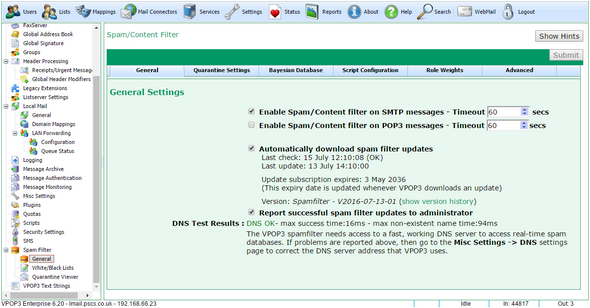
To get to this page, go to Settings → Spam Filter → General → General.
This page lets you configure the VPOP3 Spam filter and view some information about it.
The Enable Spam/Content filter on SMTP messages option tells VPOP3 whether to pass messages it receives using SMTP through the spam filter. This includes internal and incoming SMTP messages.The spam filter knows when a message is sent from a trusted IP address or authenticated user. If so, it does not test to see if the message is spam, instead it trains the Bayesian spam filter that this is a 'good' message, and optionally adds the recipient(s) into the spam filter whitelist so that any replies will be allowed through the spam filter.
The Enable Spam/Content filter on POP3 messages option tells VPOP3 whether to pass messages it downloads using POP3 through the spam filter. This will only include incoming messages.
The Timeout options tell VPOP3 how long the spam filter should run before it gives up. For incoming SMTP, if it times out it will send a 'temporary reject' response to the sender which will tell them to try again later. For incoming POP3, the message will be handled as if not spam. Generally, on a well specified server the filter should take no more than a few seconds - most of this time will be waiting for DNS responses.
The Automatically download spam filter updates option should be turned on if you have a subscription to our spam filter updates. If you don't have a subscription, then you can still use the spam filter, but you will not receive updates to handle the latest spam, so it will be less effective. You can update the spam filter yourself if you wish - the script language definition is available on our website to help you.
If the updates are turned on, then beneath that option is status information showing when VPOP3 last checked for updates, last downloaded updates, when your subscription expires, etc.
The Report successful spam filter updates to administrator option tells VPOP3 to tell the administrator when it has downloaded an update successfully. VPOP3 will always tell the administrator if it has failed to check for updates successfully for an extended period of time.
The spam filter uses DNS servers for accessing real-time databases to help with spam filtering, such as blacklists, whitelists etc. The DNS Test Results section shows the access times for retrieving existing and non-existent DNS results. If these are too high, then it may suggest a problem with the DNS server which VPOP3 is using. That may lead to less accurate filter results, or slow performance.

